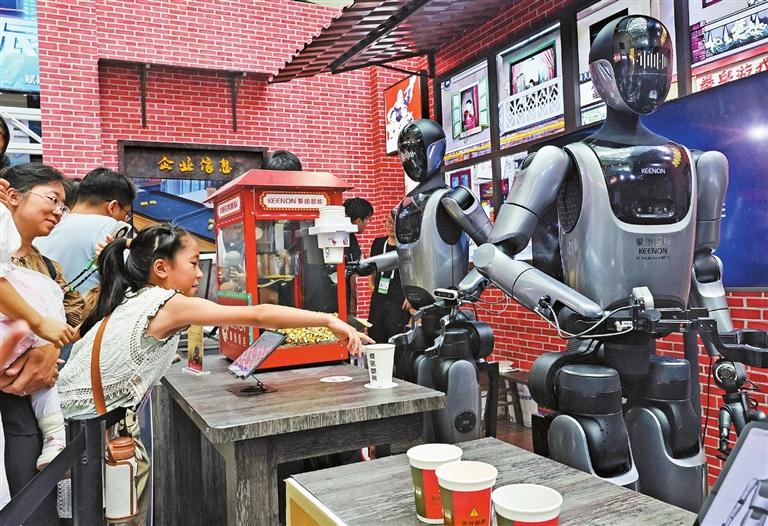
MORE than 150 robots made a strong collective presence at the four-day exhibition held alongside this year’s World Artificial Intelligence Conference (WAIC) in Shanghai, which kicked off Saturday. Around 60 intelligent robot models from 80 companies specializing in embodied intelligence debuted at the event. Not only have their numbers surged, but these robots have also become more capable, adapting to a wide range of application scenarios. Leading players Shenzhen-based Dobot Robotics showcased its latest robotic arm equipped with Tencent Robotics X’s VLA large-language model (LLM). Demonstrating advanced human-machine interaction capabilities, the robotic arm can engage in natural dialogue, interpret user intent, assess its surroundings, reject unreasonable commands, and respond accordingly. “The VLA model, unlike conventional AI, enables real-time decision-making and task execution, marking a shift towards more adaptable, general-purpose embodied intelligence,” said a Dobot representative, adding that traditional robots are limited to performing specific, repetitive tasks. Another Shenzhen-based company, Cyborg Robotics, introduced the Cyborg-R01 — China’s first heavy-duty humanoid robot. Designed for industrial scenarios such as heavy load handling, this model aims to advance automation and smart manufacturing. Hangzhou-based Unitree Robotics featured a range of embodied AI innovations at WAIC. Its boxing robot stood out by showcasing high cognitive and motor intelligence through precise movements. Capable of handling intricate tasks like drumming and calligraphy, the robot was demonstrated in various scenarios that emphasized its versatility. On Friday, Unitree officially unveiled its third-generation humanoid robot, the “Unitree R1 Intelligent Companion.” Weighing just 25 kilograms, this robot supports flexible development and customization and integrates a multimodal LLM with both voice and vision capabilities. Deep Robotics, also based in Hangzhou, presented an upgraded version of its flagship quadruped robotic dog, the X30, tailored for different industrial applications, alongside the Lite3 robotic dog, designed for consumer and educational uses. The X30 can replace human power inspectors by accurately identifying inspection targets such as power system pointer gauges and infrared temperature meters, while assessing system conditions. Deep Robotics’ solutions have been deployed in over 600 scenarios worldwide, with its quadruped robots holding an 80% market share in sectors such as power inspection. Shanghai-based Keenon Robotics launched its bipedal humanoid service robot XMAN at the WAIC. With agile mobility and mature interactive capabilities, this robot is suited for hospitality and catering environments. Keenon CEO Li Tong noted that China’s competitive edge in service-type humanoid robots stems from a highly efficient supply chain, strong expertise in algorithms and data collection, and a rich pool of local engineering talent. Future trends Technological advancements and market demand have rapidly propelled China’s humanoid robotics sector from the lab into practical applications, said Jiang Lei, chief scientist at the National and Local Co-Built Humanoid Robotics Innovation Center. The integration of embodied intelligence with large-language models is key to this progress, he added. Many robots can now perform precision tasks, and with ongoing improvements in data collection and sensor technology, they are expected to achieve millimeter-level accuracy and expand into industries such as retail, healthcare, and logistics. Jiang pointed out that although the U.S. led early development of robots capable of walking, running, and jumping, Chinese teams have caught up in recent years. “This year could mark the watershed moment that China perfects humanoid mobility,” he said. While core algorithms remain a work in progress, Jiang believes China is well-positioned in the embodied intelligence race, with advantages in manufacturing and data that enable participation in setting global standards. Meanwhile, on Saturday, agreements were signed between robotics companies and Jiang’s center in Shanghai to establish a collaborative ecosystem for robot training. Analysts from China International Capital Corp. (CICC) confirm that although most current orders for humanoid robots come from universities and a few leading manufacturers, industries facing high labor costs are expected to adopt humanoid robots by 2030. By then, the robotics penetration rate in information technology, equipment manufacturing, and logistics sectors is projected to reach 50%. Adoption in residential services, hotels, and restaurants is also expected to grow steadily after 2035.(SD News) | 
